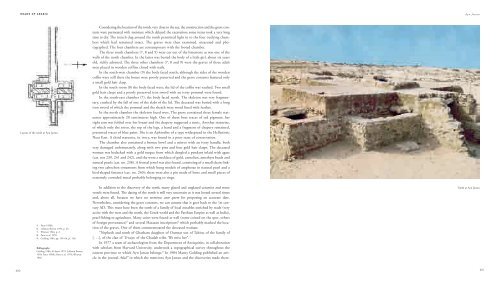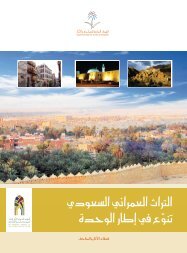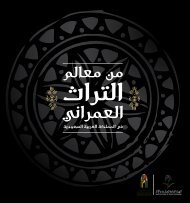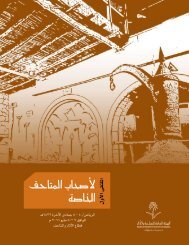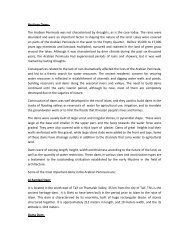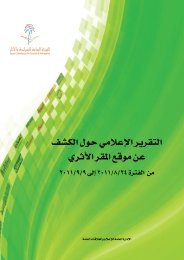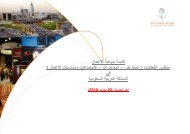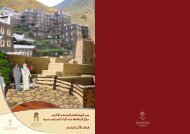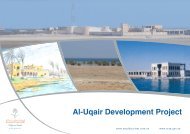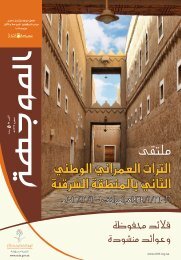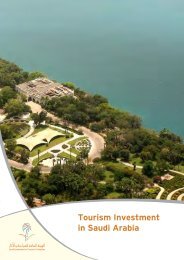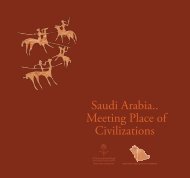Roads of Arabia
Roads of Arabia
Roads of Arabia
Create successful ePaper yourself
Turn your PDF publications into a flip-book with our unique Google optimized e-Paper software.
22 Arabie US p398-403_BAT.qxd 23/06/10 21:56 Page 400<br />
ROADS OF ARABIA<br />
Ayn Jawan<br />
Layout <strong>of</strong> the tomb at Ayn Jawan<br />
Considering the location <strong>of</strong> the tomb, very close to the sea, the construction and the grave contents<br />
were permeated with moisture which delayed the excavation; some items took a very long<br />
time to dry. The trench dug around the tomb permitted light in to the four outlying chambers<br />
which had remained intact. The graves were then examined, measured and photographed.<br />
The four chambers are contemporary with the looted chamber.<br />
The three south chambers (7, 8 and 9) were cut out <strong>of</strong> the limestone as was one <strong>of</strong> the<br />
walls <strong>of</strong> the north chamber. In the latter was buried the body <strong>of</strong> a little girl, about six years<br />
old, richly adorned. The three other chambers (7, 8 and 9) were the graves <strong>of</strong> three adult<br />
men placed in wooden c<strong>of</strong>fins closed with nails.<br />
In the south-west chamber (9) the body faced south; although the sides <strong>of</strong> the wooden<br />
c<strong>of</strong>fin were still there the bones were poorly preserved and the grave contents featured only<br />
a small gold hair clasp.<br />
In the south room (8) the body faced west; the lid <strong>of</strong> the c<strong>of</strong>fin was vaulted. Two small<br />
gold hair clasps and a poorly preserved iron sword with an ivory pommel were found.<br />
In the south-east chamber (7), the body faced north. The skeleton was very fragmentary,<br />
crushed by the fall <strong>of</strong> one <strong>of</strong> the slabs <strong>of</strong> the lid. The deceased was buried with a long<br />
iron sword <strong>of</strong> which the pommel and the sheath were wood lined with leather.<br />
In the north chamber the skeleton faced west. The grave contained three female statuettes<br />
approximately 20 centimetres high. One <strong>of</strong> them bore traces <strong>of</strong> red pigment; her<br />
right arm was folded over her breast and the drapery suggested a tunic. Another statuette,<br />
<strong>of</strong> which only the torso, the top <strong>of</strong> the legs, a hand and a fragment <strong>of</strong> drapery remained,<br />
presented traces <strong>of</strong> blue paint. She is an Aphrodite <strong>of</strong> a type widespread in the Hellenistic<br />
Near East. A third statuette, in ivory, was found in a poor state <strong>of</strong> conservation.<br />
The chamber also contained a bronze bowl and a mirror with an ivory handle, both<br />
very damaged unfortunately, along with two pins and four gold hair clasps. The deceased<br />
woman was bedecked with a gold torque from which dangled a pendant inlaid with agate<br />
(cat. nos 239, 241 and 242), and she wore a necklace <strong>of</strong> gold, carnelian, amethyst beads and<br />
natural pearls (cat. no. 238). A frontal jewel was also found, consisting <strong>of</strong> a small chain linking<br />
two cabochon ornaments from which hung models <strong>of</strong> amphorae in natural pearl and a<br />
bird-shaped fastener (cat. no. 240); there were also a pin made <strong>of</strong> bone and small pieces <strong>of</strong><br />
extremely corroded metal probably belonging to rings.<br />
5. Potts 1990b.<br />
6. LeBaron Bowen 1950, p. 23.<br />
7. Winnett 1946, p. 2.<br />
8. Potts et al. 1978.<br />
9. Golding 1984, pp. 159–64, pl. 156.<br />
Bibliography:<br />
Golding 1984; Al-Jasser 1979; LeBaron Bowen<br />
1950; Potts 1990b; Potts et al. 1978; Winnett<br />
1946.<br />
In addition to the discovery <strong>of</strong> the tomb, many glazed and unglazed ceramics and stone<br />
vessels were found. The dating <strong>of</strong> the tomb is still very uncertain as it was looted several times<br />
and, above all, because we have no terminus ante quem for proposing an accurate date.<br />
Nevertheless, considering the grave contents, we can assume that it goes back to the 1st century<br />
AD. This must have been the tomb <strong>of</strong> a family <strong>of</strong> local notables enriched by trade (very<br />
active with the west and the north, the Greek world and the Parthian Empire as well as India),<br />
pearl fishing or agriculture. Many coins were found as well (some coined on the spot, others<br />
<strong>of</strong> foreign provenance) 5 and several Hasaean inscriptions 6 which probably marked the location<br />
<strong>of</strong> the graves. One <strong>of</strong> them commemorated the deceased woman:<br />
“Nephesh and tomb <strong>of</strong> Ghatham daughter <strong>of</strong> Oumrat son <strong>of</strong> Tahiou <strong>of</strong> the family <strong>of</strong><br />
[. . .], <strong>of</strong> the clan <strong>of</strong> ‘Uwayr, <strong>of</strong> the Chadab tribe. We miss her”. 7<br />
In 1977 a team <strong>of</strong> archaeologists from the Department <strong>of</strong> Antiquities, in collaboration<br />
with scholars from Harvard University, undertook a topographical survey throughout the<br />
eastern province to which Ayn Jawan belongs. 8 In 1984 Marny Golding published an article<br />
in the journal Atlal 9 in which she mentions Ayn Jawan and the discoveries made there.<br />
Tomb at Ayn Jawan<br />
400<br />
401


